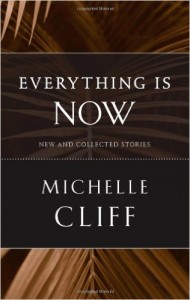 Everything Is Now: New and Collected Stories
Everything Is Now: New and Collected Stories
by Michelle Cliff
University of Minnesota Press
248 pages, $24.95
THIS VOLUME is actually a compilation of two previously published collections of short stories and a set of new ones by Jamaican-born writer Michelle Cliff, who has taught at various universities in the United States. These stories occupy an impressive range of settings and genres, from contemporary realism to historical and fantasy fiction.
The title story, “Everything Is Now,” is about a woman, Cassandra, who’s on her way to visit her female lover when she suddenly enters the 1940’s, where a woman, Grace, has just received a telegram telling her that her boyfriend has been killed in the war. A
These stories resemble Impressionist paintings, full of sensuous imagery and emotion. Their plots are generally nonlinear, and the shorter pieces look like prose poems. Without preaching, the author shows the horror of racist abuse, woman hatred, and homophobia in the context of a colonial, class-divided system. Most of these stories involve several interlocking types of oppression. Homophobia appears as part of a social system in which “misfits” are usually confined to institutions: reform schools, psychiatric hospitals, old-age homes. Or they simply disappear from the environment in which they are first seen.
Several of the stories appear to be autobiographical. The speaker in “My Grandmother’s Eyes” explains that her grandmother left the story of her life in a sealed box to be opened only after her death and read only by her granddaughter. She describes her birth in Jamaica as the result of her mother’s extramarital “mistake,” and being sent to live with her own chilly grandmother. Eventually, she’s driven away to “seek her fortune” in 1920’s New York, where her green eyes and exotic looks—in the terminology of the time, she is an “octoroon”—win her a job as a dancer at the Cotton Club. They also attract the interest of a female painter who gently persuades her to pose nude. The sittings become sexual trysts that are literally drenched in golden sunlight, but the secret affair is doomed to be short-lived and never to be revealed during the grandmother’s lifetime.
The theme of “everything is now” links the historical stories (set before the author was born) with others that connect the author’s childhood and youth with contemporary events, such as the Civil Rights movement of the 1950’s and 60’s. There are also stories set in the 1980’s, 90’s, and in the present, but most of these are focused on the persistence of memory or the influence of the past, both collective and personal, on the present. Same-sex desire runs like a bright, fragile thread through these stories, but there is no mention of a movement for “gay rights” and no hint that mainstream culture might have changed.
In “Crocodilopolis,” a young Englishwoman tells the story of her journey to Egypt in 1905 with her brother and his male friend. She discovers an ancient sacred city, dedicated to the crocodile god and described as “a place of dalliance.” She remembers her grandmother, who also tried to escape from a conventional feminine life. However, the narrator is trying to forget an affair that haunts her memory: “What possible future could we have? Two intelligent, beautiful women (my grandmother had taught me to detest false modesty) going at each other hammer and tongs, tongues, nipples, the glorious space between our legs. Madness. Complete. We had in our misbehaviour no center of gravity.”
In “Rubicon,” a married woman leaves her young daughter to wait for her in a half-deserted bar run by three women (Ruby, Billie, and Connie), former singers in a band that never had a hit. This event is a ritual that takes place every Thursday afternoon, when the mother promises to come back for her daughter in an hour, then goes to an upstairs bedroom to join her female lover. At one point, the mother says, “I wish there was somewhere else we could go.” The lover has no answer for her.
In the complex “Bodies of Water,” a conservative niece is horrified when her elderly aunt is named in the newspaper as “the sole survivor” of an unrelated woman who has just died. The niece’s husband tells her: “Any reasonable person will see it for what it is. … Two old maids. That’s all.” A younger woman, Jess, stays in the summer cottage of her beloved brother, feeling guilty because she couldn’t protect him from their parents after they read his diary and learned about his “abnormal” feelings. The parents sent Bill for expensive “treatments” which “didn’t take,” so “He was sent to a tough place up the Hudson, where they taught him carpentry. And when he returned, he knew enough to build some shelves for his mother’s spices and to ask a girl to the Junior Prom.” Now the adult Bill seems to be dying, and his sister Jess is his only heir.
These stories have a compelling beauty which almost distracts the reader from their themes of loneliness, regret, and nostalgia for past dreams that have never been fulfilled. This collection is a good introduction to the work of the acclaimed author of If I Could Write This in Fire (2008), a collection of essays, and the novels Abeng (1984), No Telephone to Heaven (1987), and Free Enterprise (1993).
Jean Roberta is a widely published writer who lives in Regina, Saskatchewan.






